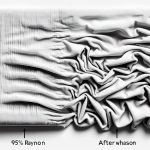Are you ready to navigate the intricate world of fabrics and find the one that best suits your needs?
Like a skilled artisan selecting the finest tools, choosing the right fabric is essential for mastering the art of dressing.
From the timeless appeal of cotton to the luxurious elegance of silk, each fabric offers unique qualities to consider.
In this exploration, we will delve into the characteristics of cotton, silk, polyester, wool, linen, rayon, and nylon, revealing their strengths and limitations.
By understanding the properties of each fabric, you can make informed decisions that align with your preferences and requirements.
Let's embark on this journey to uncover which fabric is best for you.
Key Takeaways
- Natural fabrics such as cotton, silk, wool, and linen offer durability, breathability, and moisture-wicking properties.
- Rayon, a synthetic fabric derived from wood pulp, is a versatile and affordable alternative to natural fibers, with superior moisture-wicking abilities.
- Rayon provides comfort, breathability, and a soft luxurious feel, and is derived from renewable sources.
- Nylon is highly durable and resistant to wear and tear, making it a popular choice for outdoor gear, with superior strength and abrasion resistance compared to polyester.
Cotton: The All-Purpose Fabric
When choosing fabrics, consider that cotton is a versatile and comfortable choice for various clothing and household items. Cotton is known for its durability, making it an excellent option for everyday wear and tear. Whether it's for a pair of sturdy jeans or a durable kitchen towel, cotton can withstand repeated use and multiple washings without losing its shape or strength.
In addition to its durability, cotton is also highly breathable, making it an ideal choice for warm-weather clothing. The natural fibers allow air to circulate and moisture to evaporate, keeping you cool and comfortable.
While cotton offers impressive durability, it may not match the luxurious feel of silk. Silk is renowned for its softness and smooth texture, making it a popular choice for high-end clothing and bedding.
However, when it comes to practicality and everyday use, cotton's durability and comfort make it a top contender for a wide range of garments and household items.
Silk: Luxurious Elegance or High Maintenance
When it comes to silk, you may be drawn to its luxurious elegance. However, it's important to consider its high maintenance nature. Silk is a delicate fabric that requires special care to maintain its luster and longevity.
Understanding the care tips for silk will help you make the most of this exquisite material.
Silk: Luxe but Delicate
You may find that silk fabric requires careful handling and maintenance to preserve its luxurious elegance. Silk is a delicate fabric that demands special attention for longevity and quality. Here are some important points to consider:
- Gentle Care: Silk should be hand washed or dry cleaned to maintain its luster and strength.
- Avoiding Abrasion: Silk is prone to abrasion, so it's essential to handle it with care to prevent damage.
- Protection from Sunlight: Prolonged exposure to sunlight can weaken silk fibers, so store silk garments away from direct sunlight.
Silk's luxurious elegance comes with the need for meticulous care and attention to ensure its durability and longevity. By following proper silk care practices, you can continue to enjoy the timeless beauty and sophistication that silk fabric offers.
Silk: Care Tips Needed
For maintaining the luxurious elegance of silk fabric, it is essential to carefully follow specific care tips. Silk is a delicate fabric that requires proper handling to maintain its luster and smooth texture. Follow these silk care tips to keep your silk garments and linens in pristine condition:
| Silk Care Tips | Instructions |
|---|---|
| Washing Instructions | Hand wash with mild detergent or dry clean only. |
| Silk Storage | Store in a cool, dry place away from direct sunlight. |
| Preventing Wrinkles | Hang silk items to air dry or use a steamer on low heat. |
| Ironing | Use a low heat setting and a pressing cloth to iron silk. |
| Stain Removal | Blot stains with a damp cloth and avoid rubbing vigorously. |
Following these care tips will help preserve the luxurious elegance of your silk items for years to come.
Polyester: Affordable and Versatile
Polyester fabric offers affordability and versatility, making it a popular choice for a wide range of clothing and household items. When considering polyester, it's essential to understand its key attributes:
- Durability and Comfort: Polyester is known for its strength and resilience, making it ideal for items that require frequent washing or heavy use. Additionally, it provides a comfortable and soft feel against the skin, making it a practical choice for a variety of garments.
- Easy Care and Maintenance: One of the standout features of polyester is its low-maintenance nature. It's resistant to wrinkles, shrinking, and fading, simplifying the upkeep of clothing and household textiles. This easy-care aspect makes it a favored option for those with busy lifestyles.
- Versatility: Polyester's adaptability allows it to be blended with other fibers, resulting in a wide array of fabric options. Whether it's a high-performance athletic wear or a luxurious bedding set, polyester's versatility makes it suitable for various applications.
With its durability, comfort, easy care, and versatility, polyester fabric continues to be a practical and widely utilized choice across the textile industry.
Wool: Warmth and Natural Insulation
When considering warmth and natural insulation in fabrics, wool stands out as a reliable and time-tested choice that can provide exceptional comfort and performance. Its unique properties make it an ideal option for a wide range of cold-weather clothing and accessories.
Wool's natural crimp creates insulating air spaces that retain heat, making it highly effective in keeping you warm. In comparison to cotton, wool excels in insulation due to its ability to trap more air, thus providing better warmth. Additionally, wool fibers can absorb moisture vapor without becoming damp, helping to regulate body temperature and ensuring comfort in varying weather conditions.
When juxtaposed with silk and polyester, wool offers a balance between luxury and practicality. While silk is often associated with luxury, it lacks the insulating properties of wool, making it less suitable for cold weather. On the other hand, polyester, known for its affordability and versatility, falls short in terms of natural insulation and moisture-wicking capabilities when compared to wool.
Wool's ability to provide warmth, regulate temperature, and offer natural insulation makes it a superior choice for those seeking both comfort and performance in cold climates.
Linen: Lightweight and Breathable
Linen is a lightweight and breathable fabric that offers excellent comfort and breathability, making it a great choice for warm weather clothing. When considering linen for your wardrobe, it's important to understand its key features:
- Wrinkle Resistance: Linen is known for its natural crinkled texture, which not only adds to its aesthetic appeal but also contributes to its wrinkle resistance. This means that linen clothing tends to hold its shape well, even after prolonged periods of wear, making it a practical choice for those who prefer low-maintenance garments.
- Moisture Wicking: One of linen's most prized qualities is its ability to wick away moisture from the body, keeping you feeling cool and dry in hot and humid conditions. This moisture-wicking property makes linen an ideal fabric for summer attire, as it helps to regulate body temperature and prevent the discomfort associated with perspiration.
- Breathability: Linen's open weave and natural fibers allow for excellent air circulation, promoting ventilation and ensuring that heat doesn't get trapped against the skin. This breathability makes linen a popular choice for warm climates and outdoor activities where comfort is paramount.
Rayon: The Synthetic Alternative
When it comes to choosing fabrics, you may have considered rayon as a synthetic alternative to natural fibers. Understanding the differences between rayon and natural fibers, as well as the benefits and environmental impact of rayon, can help you make an informed decision.
Exploring these points will provide valuable insight into the qualities and considerations associated with rayon as a fabric choice.
Rayon Vs. Natural Fibers
Have you ever wondered how rayon compares to natural fibers as a synthetic alternative?
Rayon, known for its softness and breathability, is derived from wood pulp, making it a sustainable manufacturing option. Its properties mimic those of natural fibers, offering a luxurious feel with a more eco-friendly production process.
When comparing rayon to cotton, rayon has superior moisture-wicking abilities, making it an excellent choice for activewear and warm-weather clothing. Additionally, rayon drapes well and is more affordable than many natural fibers, making it a versatile option for various types of clothing.
However, it's important to consider the environmental impact and the specific requirements of the garment when choosing between rayon and natural fibers.
Benefits of Rayon
If you're looking for a versatile and eco-friendly synthetic fabric, rayon is worth considering. Rayon offers numerous benefits, making it a popular choice in the fashion industry.
One of its primary advantages is its breathability and moisture-wicking properties, providing comfort for the wearer. Additionally, rayon has a soft and luxurious feel, resembling natural fibers such as silk and cotton.
Its production process also contributes to its appeal, as it's derived from renewable sources such as wood pulp and bamboo, making it a more sustainable option compared to traditional synthetic fabrics.
Rayon is also highly versatile, blending well with other fibers to enhance durability and drape.
When considering the benefits and production process, rayon emerges as a compelling synthetic alternative for those seeking both performance and sustainability in their clothing choices.
Environmental Impact of Rayon
Considering the environmental impact, rayon stands out as a synthetic alternative that offers both versatility and sustainability.
Sustainable production methods, such as closed-loop processing, are used to create rayon, reducing the environmental impact by minimizing waste and chemical usage.
Additionally, rayon is biodegradable, making it an eco-friendly alternative to other synthetic fabrics. Its ability to decompose naturally at the end of its lifecycle reduces its environmental footprint.
When compared to other synthetic fabrics, rayon's biodegradability sets it apart as a more sustainable option.
In the quest for eco-friendly alternatives, rayon's biodegradable nature and sustainable production processes make it a compelling choice for those seeking to minimize their environmental impact.
Nylon: Strength and Durability
When choosing a fabric for durability and strength, consider using nylon due to its exceptional resistance to wear and tear. Nylon is renowned for its robustness, making it a popular choice for outdoor gear such as tents, backpacks, and jackets. Compared to polyester, nylon exhibits superior durability, especially in demanding outdoor environments. Its high tensile strength and abrasion resistance make it an ideal choice for activities that require tough, long-lasting fabrics.
Nylon's versatility extends to a wide range of outdoor gear applications due to its ability to withstand harsh conditions. Its use in backpacks ensures that they can endure the rigors of hiking, camping, and other outdoor activities without sacrificing longevity. Additionally, nylon's durability makes it an excellent choice for tent materials, providing reliable protection against the elements over extended periods of use.
Frequently Asked Questions
How Do These Fabrics Compare in Terms of Environmental Impact and Sustainability?"
When comparing fabrics in terms of environmental impact and sustainability, it's important to consider factors such as ethical sourcing and eco-friendly production. By evaluating these aspects, you can make informed decisions about the most sustainable fabric options.
Are There Any Special Care Instructions or Maintenance Tips for Each Fabric?"
To maintain each fabric, follow special care instructions and maintenance tips. Different fabrics may require unique care, such as hand washing, air drying, or avoiding direct sunlight. Always refer to the specific care label for best results.
Can These Fabrics Be Easily Dyed or Printed on for Custom Designs?"
Yes, these fabrics can be easily dyed or printed on for custom designs. Consider the environmental impact and sustainability assessment when choosing. Also, ensure to follow care instructions and maintenance tips. Be mindful of allergic reactions and sensitivities.
What Are the Potential Allergic Reactions or Sensitivities Associated With Each Fabric?"
Potential reactions to different fabrics vary, with some individuals experiencing fabric sensitivities or allergy risks. It's important to consider these factors, along with environmental impact and sustainability, when choosing fabrics for custom designs, fabric applications, or industry uses.
Do These Fabrics Have Any Specific Uses or Applications in Different Industries or Settings?"
In various industries and settings, specific applications for different fabrics exist. Understanding these industrial uses can help you make informed choices for your projects or needs, ensuring the right fabric is used for the right purpose.
- Tetron Fabric for Marine Applications: Durability and Use Cases - June 18, 2025
- Tetron Fabric for Outdoor Furniture: Weather Resistance and Care - June 18, 2025
- Tetron Fabric for Wall Coverings: Style and Application Tips - June 18, 2025





